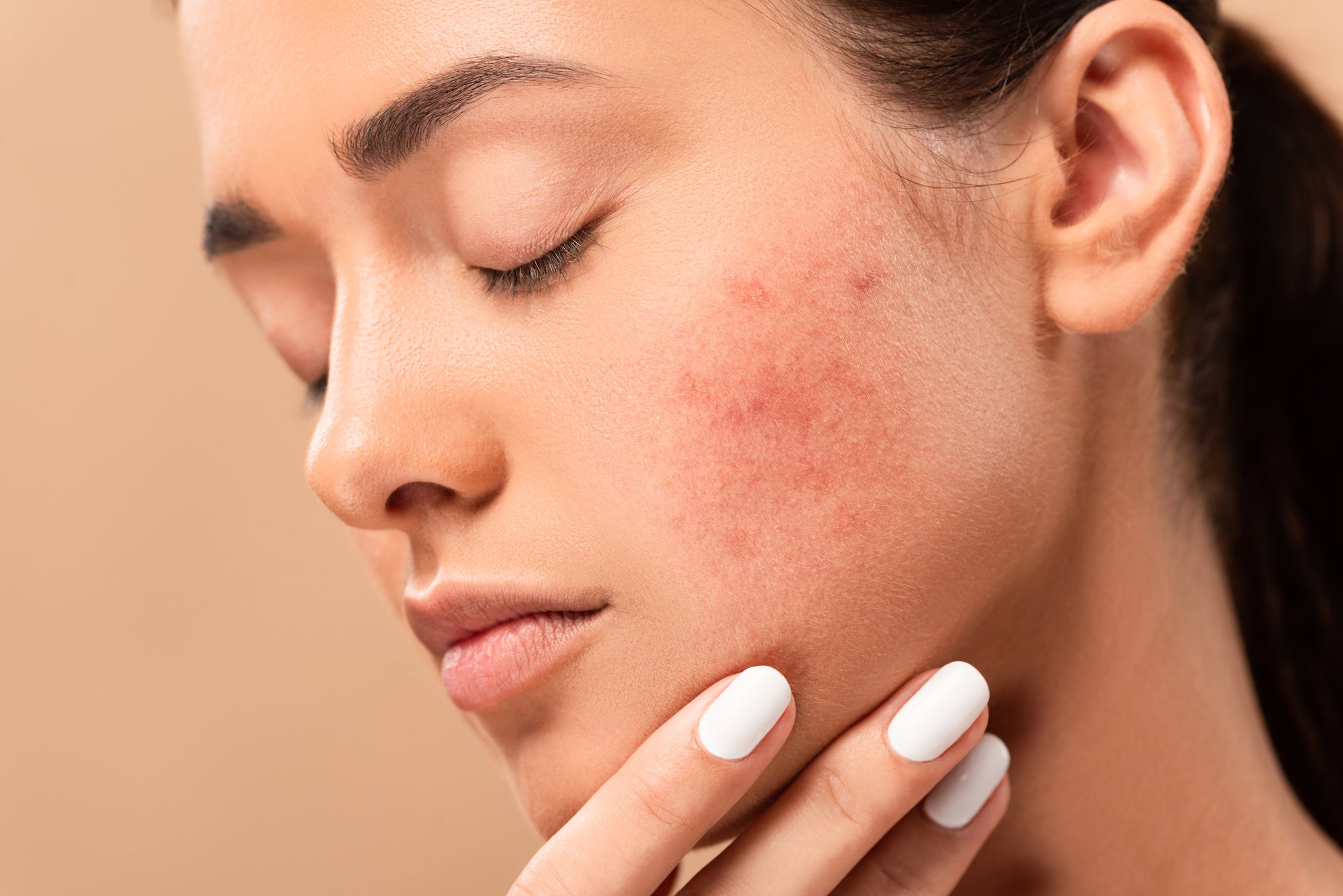
Bypass Your Breakouts: Ingredients To Avoid in Skincare
Stop me if this sounds familiar. Your complexion is temperamental, and your current skincare routine isn’t cutting it. So you pick up the latest and greatest miracle product at the drugstore and wait eagerly for results.
Fast forward a few weeks, and still no improvement. So you try another product. And another. Every time you see the same results —your face feels clean when you wash it, but your stubborn breakouts aren’t budging!
What’s the deal? How can something so refreshing be so useless?
I hate to break it to you, but many skincare products aren’t going to deliver a long-term solution for your acne.
Maybe they aren’t right for your skin type. Maybe their formulations are focused more on scent and appearance than actual effectiveness. Or maybe they cut corners, only cleansing the surface of your face without treating issues deeper down.
How can you find skincare that works for you, and avoid what doesn’t? What determines the actual effectiveness of a product?
The secret is in the ingredients list.
Specifically, there are common skincare ingredients that may be holding you back and sabotaging your clear skin goals!
1. Surfactants (The Dry Guys)
First, we’re looking at a group called surfactants.
The word surfactant is a mash-up of the words “Surface-Active Agent,” like it’s a hot new celebrity couple. (I’d like to use a timely example here, but honestly, I lost track after Brangelina.)
Surfactants are multi-purpose ingredients. They are often used in foaming products to keep the foam from collapsing back into a liquid. Other products use surfactants to marry oil-based and water-based ingredients. Many cleansers also use surfactants to reduce oiliness on your skin.
The reason that surfactants can fulfill all these roles is due to a neat quirk in their molecular structure. One end of a surfactant molecule is hydrophilic (water-loving), and the other end is hydrophobic (water-hating).

When you apply a surfactant-laden product to your face, the molecule’s tail attaches to oils and impurities on your skin. Then when you rinse, the molecule’s water-loving head binds with the splashing water and is swept away, dragging those oils and impurities along for the ride.
The problem? These surfactants don’t discriminate, carrying away all the oil from your face, including the natural sebum that is meant to hydrate and protect your skin.
Ever had that squeaky clean, tight-skinned feeling after cleansing? That’s not a good thing.
When your skin gets so parched, it will immediately respond by sending sebum production into overdrive. Suddenly, your face is oil-central, and you’re washing it more and more to keep up.
If you don’t keep washing, that excess oil might get clogged up with skin cells, plug your pores, and lead to breakouts. But if you do keep washing, you’re just drying out your skin and causing more oil production!
What’s a girl to do?
But wait, there’s more. On top of stripping your face of oils and hydration, surfactants can also interfere with your skin’s protective outer layer. This makes it more difficult for your skin to retain moisture and leaves you vulnerable to external irritants and bacteria.
Long story short? Surfactants are popular with both manufacturers and consumers because they provide instant gratification. Your skin feels cleaner and less oily...at first. But in the long run, they can make your skin (and breakouts) worse!
Don’t compromise your skin health for a temporary fix. Avoid common skincare surfactants like sulfates, which appear under names such as :
- sodium lauryl sulfate
- sodium laureth sulfate
- ammonium lauryl sulfate
Finding them hard to escape? At Averr Aglow, we’re happy to say that surfactants aren’t on the menu.
For example, our Completely Clear Gelee Makeup Remover uses something called polyglyceryl solubilizers to blend its ingredients. These solubilizers are structured similar to surfactants, but they return moisture to the skin instead of stripping it away.
And we’re often asked about the curious (and super-cute) layering in our Radiant Cleansing Nectar. It separates into those pretty, Instagrammable layers because we don’t use any skin-drying surfactants to blend the oil and water components. Just shake before use, and that’s enough to mix the Nectar’s nourishing ingredients.
Now you’ve got the perfect tough-but-gentle cleanser, without sacrificing your skin’s hydration!

2. Occlusives (The Pore Blockers)
You’ve checked all your products, and have dodged the dry-skin bullet that is surfactants. Great! But don’t get comfy, yet. At the other end of the hydration spectrum, we have oil bombs called occlusives.
Occlusive ingredients are substances that tend to block or obstruct the skin. You can guess the vibe — heavy creams, greasy lotions, or dense body butter. The kind of things better suited to hydrating the thicker skin of your hands or feet, and not the delicate skin on your face!
Now, occlusive ingredients aren’t inherently evil. If you have a dry complexion that is prematurely aging or chronically parched, they may help you lock in moisture. It just depends on your skin type.
However, using occlusives on acne-prone skin can be disastrous. Thick and oily products aren’t ideal if your skin is oily already!
Envision it. Your complexion is already drowning in sebum, and then you slather on products loaded with paraffin or mineral oil. Maybe you even apply a layer of honest-to-goodness Vaseline. These occlusive products sit like an airless barrier on top of your skin, mixing with skin cells and clogging pores.
Now you’ve got an airless, oily, probably clogged environment. It sounds like you’ve just created the perfect breeding ground for acne-causing bacteria.
Cue the breakouts!
To ward off this greasy fate, beware of treating oily skin with products that list ingredients like squalene and squalane, paraffin, mineral oil, petroleum jelly, or coconut oil (even if your sister’s auntie’s best friend’s cousin swears by it).
3. Endocrine Disruptors (The Hormonal Messes)
Next on our no-fly list is a group called endocrine disruptors. It encompasses a range of natural and synthetic chemicals that are bad for your health and bad for your complexion.
See, our endocrine system some responsible for producing and regulating hormones. But some substances can mimic or imbalance these hormones, throwing our endocrine system totally out of whack.
Who cares? You’re not a teenager ruled by the ebb and flow of hormones...right?
Wrong. Even after puberty, hormones are responsible for everything from sleep, reproduction, and metabolism to my constant, unending moodiness.
Oh, and I almost forgot. Hormones are also responsible for your acne.
Various hormones, such as cortisol and androgens, trigger your sebaceous glands to produce more sebum. All this excess oil then clings to dead skin cells and clogs your pores, and the rest is history. Spotty, breakout-plagued history.
Skip hormonal chaos from your skincare products by looking out for disruptors like parabens, phthalates, triclosan, and oxybenzone.
4. Artificial Fragrances (The Smugglers)
Turns out that artificial fragrances are not the good friends they appear to be.
Too bad, because artificial fragrances hide not only in lotions and perfumes but also in cleansers, serums, hair products, deodorants... every type of cosmetic or skincare product out there.
The problem? Artificial fragrances can sneak all sorts of chemicals and preservatives into your product. This is thanks to an FDA loophole that exempts manufacturers from listing fragrance ingredients on their packaging.
By keeping the fragrance formulations secret, skincare companies can avoid revealing the presence of unsavory chemicals in their products. This includes things like phthalates, which savvy consumers are learning to avoid.
And as you may recall, we’ve just called out phthalates as endocrine disruptors. So that delicious peach-vanilla facial scrub you just bought? Its artificial fragrance is primed to interfere with your hormones and worsen your acne.
To make matters worse, the American Academy of Dermatology calls artificial fragrances the number one cause of contact dermatitis, which can erupt in a nasty skin rash. The AAD directly recommends avoiding any products that hide behind the generic term fragrance when listing ingredients.
“No problem, Anna. I always pick fragrance-free products, anyway.”
Well, I appreciate you being conscientious, but fragrance-free may not be the solution.
Fragrance-free products might not use chemicals or synthetic fragrances. But that’s not guaranteed. Many go ahead and use those ingredients, and then smother them under additional scent-masking chemicals.
That’s not better. It’s worse!
So how do you get the actual skinny on fragrances in your products? There are two good indications of a company’s transparency here. Look for products that do one of the following :
- On the ingredients list, the dreaded term fragrance is immediately followed by parentheses listing its sub-ingredients.
- The product doesn’t use the term fragrance at all, instead proactively naming every component in its ingredient list.
Need an example? Just check out our Averr Aglow product line. Every single ingredient is listed on our website and product packaging, so you can check the contents before you use or purchase.
Spoiler alert: You don’t find any phthalates here! 😘






